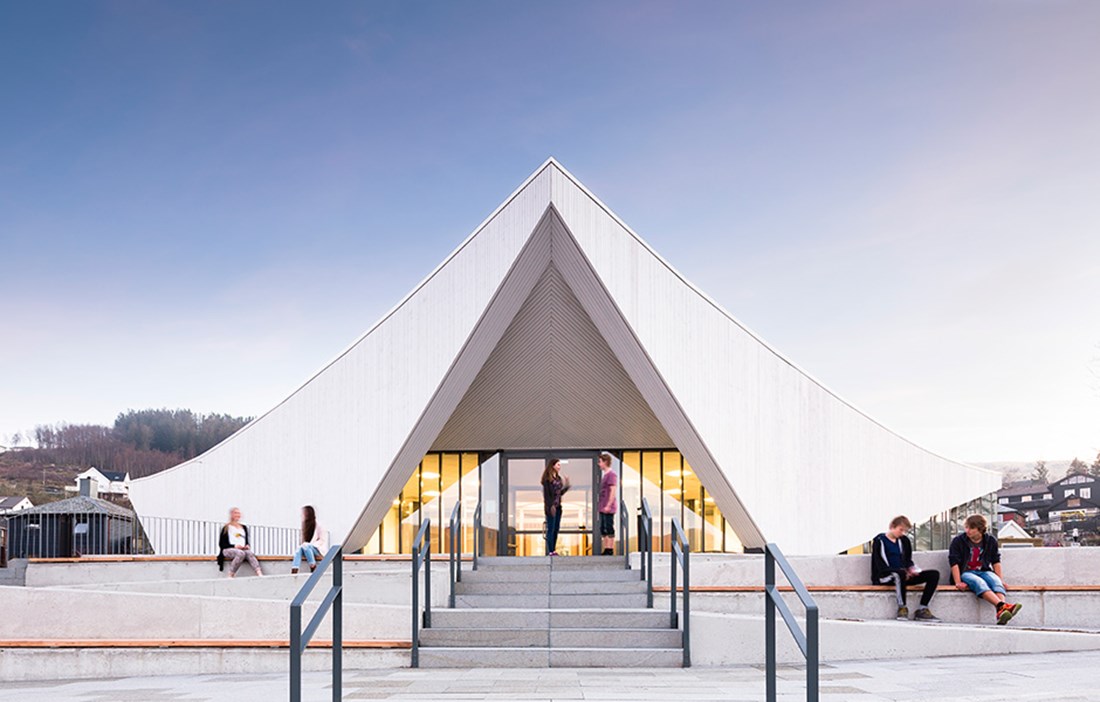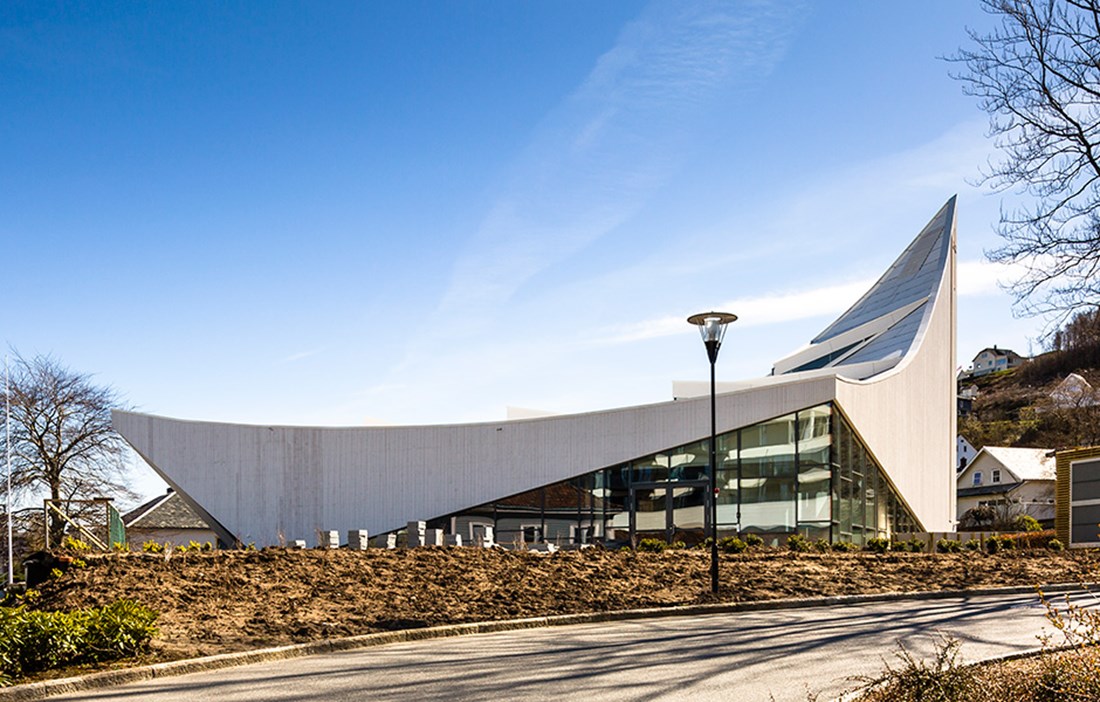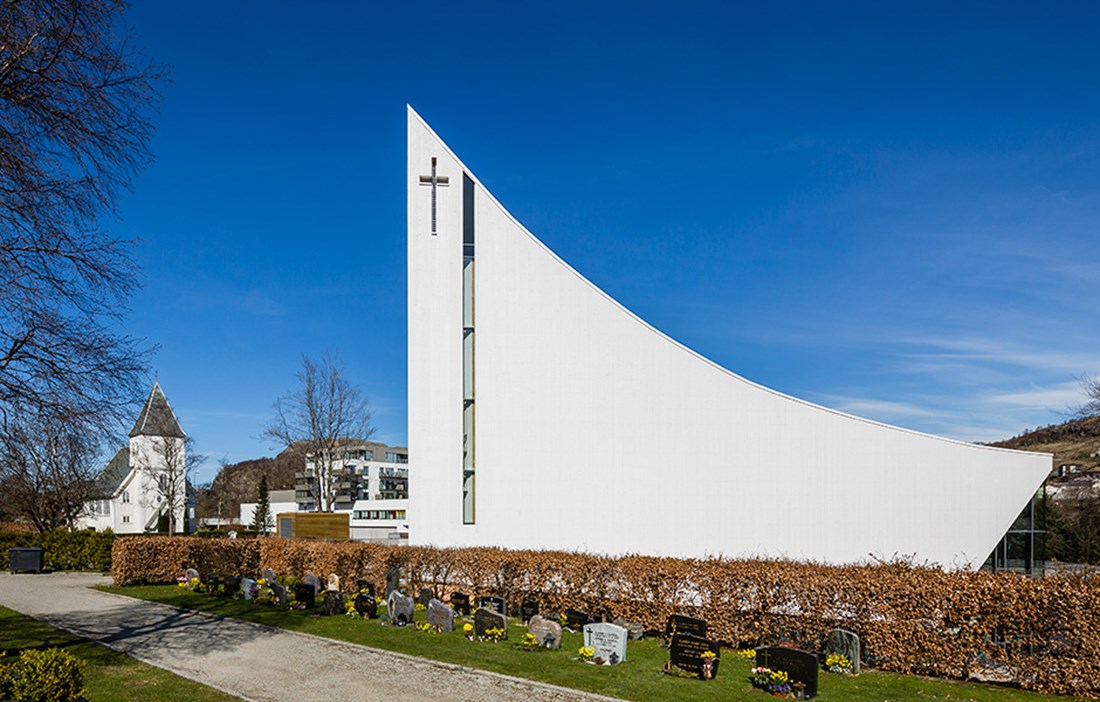A MISTY VALLEY in the evening sun. Trees and mountains as far as the eye can see. A river that flows ever so gently down at the bottom. And suddenly: an American football flies through the air, over the mountains, high above the spruce forest, and finally lands in a boy’s arms, far out on a rocky ledge. The popular YouTube videos ‘Kickalicious 1 & 2’ from a couple of years back put Norway’s Ålgård and the surrounding area on the map – but above all it took the star of the clips, Håvard Rugland, to the NFL and a career in American football.
Now Ålgård and the magnificent landscape in south-west Norway once again have the eyes of the world on them. The newly built Ålgård Church is an architectural masterpiece that has become a beautifully low-key local landmark since it opened in spring 2015. From a distance, the church looks like an enormous tent, with the white walls and sloping roof giving the impression of a light, soft canvas raised up on posts. At one end of the church, the entrance and steps symbolically face towards the village. At the other end, the church sweeps up in a gentle curve towards the sky. In one dynamic movement, the church rises up out of the landscape, like a natural continuation of Ålgård’s hills and valleys. The architectural practice behind the project is Norway’s LINK Arkitektur.
“We wanted to make the church feel like a tent, in order to create an open and inviting impression. It also symbolises Moses and the Israelites wandering through the desert. The idea was to create a modern interpretation of a traditional church,” says chief architect René de Groot.
THE CHURCH IS NOT JUST FOR Christian services – it also serves as an assembly hall for the whole community. The building contains offices, group rooms, a café, space for ballgames and dancing, rehearsal rooms and so on. The place of worship itself is on the upper floor, while all the other activities are concentrated on the lower floor. This proved something of a design challenge, since the different activities had to work together, while still being able to be kept apart.
“There are separate entrances to the church and to the lower floor. The steps up to the church itself clearly mark it out as the ‘main space’ and make it easy to find. But however you look at it, everything is housed in one and the same building. Our greatest challenge was therefore to find a solution that contained all the functions of a modern cultural building, while also ensuring it works as, and feels like, a church. We were looking for a design that had a perfect balance between sacred and user-friendly,” says René de Groot.
The shape of the church is square, with a diagonal axis. The design was driven by the client’s brief for a compact, functional and economical solution. In using a square base, with the lower floor partially dug into the ground, it was possible to create a smart solution with short distances and reduced costs for external walls. Using wood as the construction material, both internally and externally, felt like a natural choice to the architects.
“Wood is a warm and humane material, which fitted in perfectly with the function of Ålgård Church. There is also a Nordic tradition of building wooden churches, including the old church nearby, which is made of wood,” explains René de Groot.
THE FAÇADE, ROOF and structural glulam beams are spruce. The façade is painted to protect it against the elements, and is treated with a fire retardant finish. Internally, the church is fitted with sprinklers for additional fire safety. The floor of the church is laid with beautiful oak. The same wood is also used for the vertical elements that combine with white painted plasterboard to make up the interior walls. The glulam beams that have been left visible in the ceiling are one of the first details to strike visitors to the church. Together, they create a triangular pattern reminiscent of a beehive. The design has structural benefits, as well as an aesthetic and symbolic function. Arranging the beams in this way creates a rigid structure that is capable of carrying the roof. But equally important is the symbolism of the pattern, since in Christianity the triangle represents the Trinity. It is also a nod to what the vaults inside traditional churches usually look like. The pattern is further accentuated by the nine triangular windows placed in the roof.
“The building has no regular windows. The ones up in the ceiling give the impression of lifting up the ‘canvas’ and carefully letting light into different parts of the space. These windows to the heavens create contact between the inside and the outside. Additional daylight is admitted behind the altar, through the glass artwork standing there,” says René.
The church has proved a big hit with the locals. René de Groot reports that many of those who don’t usually go to church have been to this one. At the official opening earlier in the spring, the church was packed with over 600 inquisitive visitors.
They squeezed into the building to listen to the Bishop of Stavanger, Erling Pettersen, giving the church his blessing. His words made the local residents glow with pride, and LINK Arkitektur was able to relax, safe in the knowledge that they had created a modern, inclusive place for people of faith and those with none:
“This is one of the most beautiful churches I’ve ever been in. From now on, I’m going to call it the Church of the Open Arms.”
Text: Erik Bredhe

























